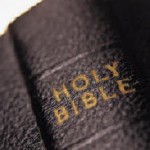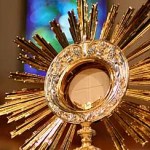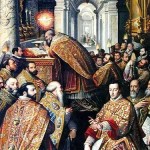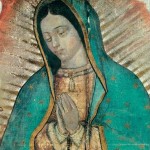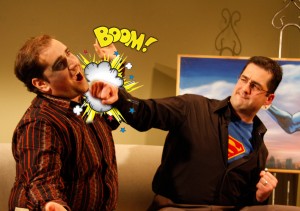 Well, gang, tonight was the premiere of the Catholic Focus episode on Superheroes and the Faith, on Salt and Light TV. In case you missed the 7 PM show, you can catch the repeat at 11 PM (all times Eastern). Don’t worry if you lack cable or satellite TV – you can catch the show in streaming format at www.saltandlighttv.org. I’ll also post the video as soon as it’s available on YouTube.
Well, gang, tonight was the premiere of the Catholic Focus episode on Superheroes and the Faith, on Salt and Light TV. In case you missed the 7 PM show, you can catch the repeat at 11 PM (all times Eastern). Don’t worry if you lack cable or satellite TV – you can catch the show in streaming format at www.saltandlighttv.org. I’ll also post the video as soon as it’s available on YouTube.
By the way, Richard Valenti, who was my fellow guest on the program, was not hurt during the filming of this episode. But, as you can see, he’ll need some Kryptonite next time if he hopes to challenge yours truly, Cale Clarke (Kent)!
For host Mary Rose Bacani’s blog post on this world-changing event, see http://saltandlighttv.org/blog/?p=9734.
Up, up, and away!
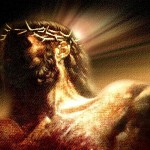 THE LIFE OF JESUS: THE GOSPEL OF MARK IN A DAY
THE LIFE OF JESUS: THE GOSPEL OF MARK IN A DAY
Cale makes the Gospel of Mark come alive as he unlocks the secrets of the first Gospel ever written. This one-day seminar walks through Jesus’ power-filled ministry as the true God-man, in a world in which the Roman Caesar was falsely worshipped as a deity.
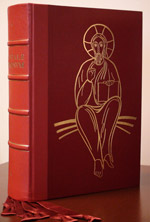
THE NEW MASS
The new English translation of the Mass that’s coming in 2011 is a perfect opportunity to do much more than simply learn the new responses we’ll have to say in the liturgy. It’s a chance to rediscover what the Mass is all about – and encounter Jesus Christ as never before.
Be sure to book Cale Clarke to speak to your group about the New Mass!
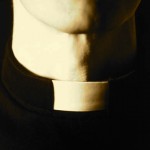
THE PRIESTHOOD EXPLAINED
The Catholic priesthood remains a mystery to many. Did Jesus intend to found it, or was it a later invention of the Church? Why are priests celibate? Why can’t women be ordained? How does the universal priesthood of the baptized differ from the ministerial, ordained priesthood? The answers to these questions will help us to truly understand and appreciate the priesthood – both Father’s, and ours.
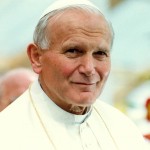 THEOLOGY OF THE BODY BY POPE JOHN PAUL II The Theology of the Body is the master key to unlocking Pope John Paul II’s vision of the “Civilization of Love” that must be built amidst the ruins of what he called the “culture of death”. Discover God’s plan for the human body, sexuality, marriage and the family with this phenomenal pope.
THEOLOGY OF THE BODY BY POPE JOHN PAUL II The Theology of the Body is the master key to unlocking Pope John Paul II’s vision of the “Civilization of Love” that must be built amidst the ruins of what he called the “culture of death”. Discover God’s plan for the human body, sexuality, marriage and the family with this phenomenal pope.
THE BIBLICAL ROOTS OF CATHOLICISM “Where is that in the Bible?” is a question frequently asked of Catholics. But far too often, silence passes for an answer. In this seminar, discover that there is nothing in the Catholic faith that contradicts the Bible – and nothing in the Scriptures that contradicts the Catholic faith. Discover why the Bible is a Catholic book, through and through – in fact, without the Catholic Church, the Bible wouldn’t exist. And in it’s pages we discover the One, Holy, Catholic, and Apostolic Church, founded by Christ and still standing today – the Catholic Church.
THE MASS: HEAVEN ON EARTH Is the Mass a “medieval invention” of the Catholic Church that replaced the sincere and pure worship of the first Christians? Or is the Mass the greatest gift Jesus bequeathed to his Church, attested by both Testaments and the testimony of history? Discover the Biblical and historical roots of the Mass, and “worship – God’s way”.
MARY: ALL ABOUT (THE NEW) EVE More so than any Catholic teachings, our doctrines and dogmas about the Blessed Mother are often called into question and misunderstood. Learn how to “stand up for your Mother” – and explain why she’s the Immaculately Conceived, Ever-Virgin Mother of God, Assumed body and soul into heaven, using Scripture, history, and plain common sense.
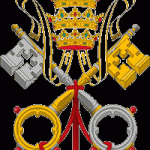
TAKE ME TO YOUR LEADER: THE BIBLICAL AND HISTORICAL ROOTS OF THE PAPACY “You are Peter, and on this rock I will build my Church”. These words of Christ, recorded in the Gospel of Matthew, are among the most famous – and famously misunderstood – words of Jesus. Learn why Peter is indeed the head of Christ’s Church on earth, both then – and now. After discovering the exciting Biblical and historical evidence for the Papacy, you’ll be able to say, along with St. Ambrose, that “Where Peter is, there is the Church”.

THE GOSPEL ACCORDING TO SUPERHEROES Is Superman a Christ Figure? What does Batman have in common with Saint Paul? Why is James Bond such a pleasure seeker? What did Spider-Man discover about Love and Responsibility? The answers may surprise you, as you discover how these heroes help us to understand the ultimate hero and the true Super Man, Jesus Christ.
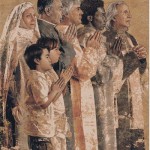
THE LIVES OF THE SAINTS In a world looking for heroes (and even superheroes), we have our very own in the Catholic Church: the saints. The only difference is, they actually exist! They, too, often exhibited supernatural “powers” – just think of St. Joseph of Cupertino’s ability to fly, Padre Pio’s bilocations and stigmata, or the Incorruptibles, like St. Pio and the most beautiful of them all, St. Bernadette of Lourdes.
One of our most neglected treasures is the lives of the saints – perhaps some of our greatest arguments for the veracity of the Faith. Whether it’s a modern-day saint like Blessed Mother Teresa, or an inspiring figure from the past like St Justin Martyr, each one is a masterpiece, God’s unique work of art. Discover how the saints of yeaterday can help us to realize God’s dream for us – to be the saints of today.
Also:
HEAVEN: WHAT YOU TRULY SEEK
MORMONISM: A CATHOLIC RESPONSE
JEHOVAH’S WITNESSES: A CATHOLIC RESPONSE
And more…
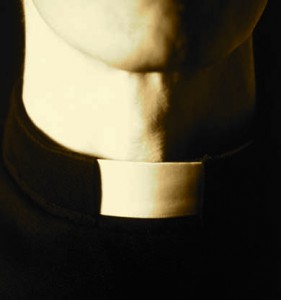 A new seminar I’m offering in this “Year of the Priest” in the Catholic Church is called “The Priesthood Explained: Understanding Father’s Priesthood – and Yours”. To whet your appetite, here’s an article I wrote on the subject for Catholic Insight magazine.
A new seminar I’m offering in this “Year of the Priest” in the Catholic Church is called “The Priesthood Explained: Understanding Father’s Priesthood – and Yours”. To whet your appetite, here’s an article I wrote on the subject for Catholic Insight magazine.
The Priesthood(s) Jesus Gave Us by Cale Clarke
A Catholic must, in the words of our first pope, “always be ready with an answer for anyone who asks you” (1 Peter 3:15) about the faith. And especially in this Year of the Priest, queries about the Catholic priesthood abound.
A fundamental question we are often asked is about the origin of the Catholic ministerial priesthood itself. Many doubt that Jesus meant to establish it. In fact, many see the priesthood as a later “invention” of the Church, a “Catholic accretion” to the gospel that must be done away with.
Speaking of 1 Peter, one major argument against the Catholic priesthood is found in 1 Peter 2:5, where all Christians are dubbed “a royal priesthood, a holy nation”. According to this text, the argument goes, since all believers are priests, a separate ministerial priesthood – the Catholic priesthood – is no longer necessary. We can return to the situation of Old Testament Israel, where all Israel was “a kingdom of priests” (Exodus 19:6). At the dawn of the Protestant revolution, Martin Luther made heavy use of the “priesthood of all believers” doctrine, as he understood it, to persuade people that they could in good conscience leave the Church of Rome.
This idea is only half true. All believers are, indeed priests. On this, the Catholic Church agrees with Peter, naturally! But that does not mean that we don’t need a separate ministerial priesthood – and, ironically, appealing to the case of Israel only strengthens the Catholic case.
As Fr. Mario Romero points out in his book Unabridged Christianity, the structure of Catholic priesthood in the New Covenant strikingly parallels that of the Old: there are three different types in each.
1. The High Priesthood. In the Old Covenant (cf. Lev. 16), The high priest was designated to enter the Holy of Holies in the Jerusalem temple and atone for the transgressions of the people on the Day of Atonement (Yom Kippur). In the New Covenant, Jesus Christ, our eternal High Priest, offers the one perfect sacrifice of himself in the true Holy of Holies (cf. Hebrews 7).
2. The Ordained, Ministerial Priesthood. Old Covenant Israel, of course, had the Levites as priests (Exodus 29 ff), who ministered on behalf of the other tribes. Some may say, “That was God’s response to the golden calf debacle, when only the Levites kept faith – prior to this, there was no unique priestly group. It is to this original state of Israel that God is calling us back to in the New Covenant”. This view fails to realize that, even prior to the establishment of the Levitical priesthood, there was already a separate priesthood (cf. Exodus 19:21,22).
The New Covenant also features an ordained, ministerial priesthood which ministers on behalf of God’s people. An oft-overlooked text that verifies this is Acts 1, when Matthias is chosen by lot to replace Judas in the apostolic band. Far from a game of chance, drawing lots is how priests were chosen for tasks in the temple (see Luke 1:9). Luke mentions this at the start of his second volume to link the new priesthood in the new temple (the Church) with the account of Zechariah’s Old Covenant priesthood in Luke 1.
Of course, there are also the stock texts one might turn to in support of a ministerial priesthood in the Church. In Romans 15:15-16, Saint Paul speaks of his “priestly service of the gospel”. The New Testament is replete with the ordinations of “presbyters” throughout – a Greek word that is translated into English as “priest” (eg. Acts 14:23, Titus 1:5).
3. The Universal Priesthood. This priesthood was shared by all Jews in the Old Covenant. It consisted of offering spiritual sacrifices to God. A similar universal, or “catholic” priesthood is conferred on all New Covenant believers at baptism, by which the believer shares in Christ’s threefold office of priest, prophet, and king (CCC 1268). All should offer the totality of their very lives (Romans 12:1) as their priestly offering to God – including their work and social lives, not simply their public and private worship. In both covenants, the ordained, ministerial priesthood is culled from the ranks of the universal priesthood.
This is the real “priesthood of all believers”. Contrary views must, sooner or later, be sacrificed on the altar of truth.
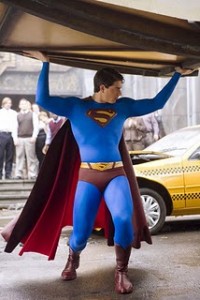 In light of my interview with Salt and Light TV tomorrow on superheroes and the faith (I’ll let you know when it airs), I thought I’d post my 2006 Superman article, published in Catholic Insight magazine, dealing with the release of the film, “Superman Returns”. You can also find my two-part article on the Batman film “The Dark Knight” in the archives here and here !
In light of my interview with Salt and Light TV tomorrow on superheroes and the faith (I’ll let you know when it airs), I thought I’d post my 2006 Superman article, published in Catholic Insight magazine, dealing with the release of the film, “Superman Returns”. You can also find my two-part article on the Batman film “The Dark Knight” in the archives here and here !
The Gospel According to Superman
by Cale Clarke
As a lifelong fan of comic book superheroes, I couldn’t wait for the latest installment of the long-dormant Superman movie franchise, Superman Returns, to swoop into theatres. And as a Catholic, watching the movie gave me more than I bargained for. I was looking for a little escapist fantasy. Instead, I found my thoughts soaring “up, up, and away”–as Superman would say-into the very heart of reality, heaven itself.
Why heaven? Because Jesus Christ is there. And Superman Returns draws some very interesting parallels between the Messiah and the Man of Steel. Just as St. Paul in Acts 17 used the works of Greek “pop culture” artists – namely, pagan poets Epimenides, Aratus, and Cleanthes – to draw first-century Athenians to Christ, there may be aspects of this movie that can connect modern spiritual seekers to the Saviour. To communicate the Gospel effectively today, we must, as St. Paul did, exegete the culture as well as the Scriptures.
Superman was created 70 years ago by Jewish teens Jerry Siegel and Joe Shuster (a Canadian!). No doubt they were thinking more of the original Moses than the new Moses (Jesus) when they dreamed up their iconic character, but the allusion to Moses is unmistakable in the Superman story. As their home planet, Krypton, is destroyed, Jor-El and his wife Lara set their infant son Kal-El adrift, not on the river Nile, but into outer space, in the hopes that a good family on Earth will raise their son as one of their own, even though he is truly a king. Of course, Jonathan and Martha Kent did just that in Smallville, Kansas, naming the boy Clark, Superman’s alter-ego.
Although the Superman legend springs from Jewish roots, just as Christianity itself does, the creators of Superman Returns have made their own mark on the character–a mark that looks an awful lot like the cross. Superman film directors like Richard Donner (1978’s Superman: the Movie) and Superman Returns’ director Bryan Singer chose to portray Superman as a Christ figure. The “S” on Superman’s chest might just as well stand for “Savior.” Singer acknowledged as much in a recent interview with Wizard magazine: “Superman is the Jesus Christ of superheroes.”
Obviously, Superman is a myth; Christ is a historical person, “born of the Virgin Mary …(Who) suffered under Pontius Pilate.” Superman is not Christ. But he is a Christlike figure, as we all should be. What we are dealing with is more of an allusion to Christ (a la Tolkien’s The Lord of the Rings), rather than a straight Christian allegory like C.S. Lewis’ Narnia series, where Aslan = Christ. But Superman Returns’ Christian allusions are no illusion.
Consider: Superman is sent to earth as a baby in a rocket ship shaped like a star, which lands in a rural cornfield. Christ’s arrival was also heralded by a star seen by shepherds in a field. Superman is raised on earth in a “backwater” town reminiscent of Nazareth: Smallville. Like Christ, Superman grows up where people have no idea of the powers he possesses, or what his true
identity – hiss true nature, a Catholic might say – really is.
Jesus was raised by an earthly stepfather named Joseph, a carpenter. Clark (which, incidentally, means “cleric”) was also raised by a manual labourer, farmer Jonathan Kent. Ironically, Clark’s parents were originally named Mary and Joseph in the comics, but later were changed to Martha and Jonathan. Superman’s Kryptonian father, Jor-El, sends Kal-El to earth with these words in Superman Returns: “They can be a great people, Kal-El; they wish to be. They only lack the light to show them the way. That is why I have sent them you, my only son.”
If this does not evoke echoes of John’s gospel, I don’t know what does! Jesus is “the light of the world” (John 1:4,5,9; 8:12) and God’s one and only Son (John 3:16,18). The early Church’s members were first called members of “the Way” (Acts 9:2). Jesus Himself said, “I am the way, the truth, and the life” (John 14:6).
Interestingly, “El” is Hebrew for God, which may or may not have had some significance in the creation of the Kryptonian names of Superman and his father. El the father and El the son evoke the Trinity, as does the line repeated by Jor-El and Superman in Superman Returns, “The son becomes the father, and the father, the son.” Jesus said to Philip: “Anyone who has seen me has seen the Father” (John 14:9).
Superman hovers above earth and listens, via his super-hearing, to myriad cries for help from below. This scene echoes what he will later tell Lois: “You said the world doesn’t need a saviour. But every day, I hear people crying for one.” Superman answers those cries, flying to the rescue, faster than a speeding bullet, breaking the sound barrier with a boom. This recalls Christ’s hearing our prayers on earth. His response is even faster than Superman’s. God “is an ever-present help in trouble” (Psalm 46:1).
Superman’s mortal enemy is Lex Luthor: a name that phonetically evokes that of Lucifer. Luthor is insanely jealous of Superman’s powers, just as Lucifer was of God. There is a scene where Superman, weakened by Kryptonite, is savagely beaten by Luthor and his thugs. The violence is raw and very reminiscent of The Passion of the Christ. Seeing Superman stripped of his powers and thrashed reminds one of Jesus, holding back His great power, brutalized by the people he came to save. Superman is then stabbed in the side by Luthor with a shard of Kryptonite, an unmistakable allusion to the lance which pierced the heart of Christ on the cross.
Luthor’s gal pal Kitty Kowalski calls to mind Pontius Pilate’s wife Claudia, who tells Pilate not to harm Jesus, having been warned in a dream. Kitty is visibly disturbed during Superman’s beating, and later throws away Kryptonian Crystals possessed by Lex, which had given him the edge in his battle against Superman.
Just as Christ did away with sin through His death, burial, and resurrection, Superman, after saving earth, falls (in a cruciform
pose) from space to earth, where his impact “buries” him in a crater, seemingly dead. Is this the end for Superman? Not if Warner Brothers wants another sequel!
Much more can be said, more than we have space for here. Of course, the comparisons between Superman and Christ end when it comes down to the main surprise of the film (caution: spoiler ahead!): Superman has fathered a child out of wedlock with Lois Lane. No allusion to Christ here; Jesus was celibate and fathered no children, no matter what Dan Brown says.
Superman’s son, Jason, was conceived by Superman and Lois’ illicit union in Superman II. As a lifelong Superman fan, this is one development of his onscreen mythology that I have a huge problem with. Superman was always known for his moral purity; filmmakers Donner and Singer have taken far too much licence here, in a misguided attempt to make Superman “relatable” to modern viewers.
But they forget that what attracts us to the character of Superman is, well, his character, as well as his saving powers. He is to, as Jor-El intones in the film, “inspire others to moral good.” And what people are attracted to in Superman–the qualities and powers of a saviour–can only be found in the reality of Christ, the true Super Man.
In the movie, Superman returns after a long disappearance. We, too, are waiting for our hero, Jesus, to return in glory. However, as Catholics, we are not asking Our Lord, as Lois does of Superman after his long absence, “How could you leave us like that?” We always have Christ’s Real Presence in the Eucharist, where He never leaves us or forsakes us. “I am with you always” (Matt. 28: 20).
Really, we can all identify a lot with Superman, because we are all aliens of a sort. This world is not our home, but “our citizenship is in heaven. And we eagerly await a saviour from there”–no, not Superman–“the Lord Jesus Christ, who … will transform our lowly bodies so that they will be like his glorious body” (Phil 3:20-21). When He returns, we will all be Super.
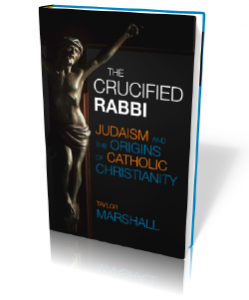 Happy New Year! Here’s my latest column for Catholic Insight magazine, a review of Taylor Marshall’s The Crucified Rabbi. Give yourself a gift this Christmas, and read this book!
Happy New Year! Here’s my latest column for Catholic Insight magazine, a review of Taylor Marshall’s The Crucified Rabbi. Give yourself a gift this Christmas, and read this book!
“The Crucified Rabbi” reviewed by Cale Clarke
Does the Pope wear a yarmulke?
That query, along with many others, is answered by Taylor Marshall in his new book, The Crucified Rabbi: Judaism and the Origins of Catholic Christianity (Saint John Press, 2009, www.crucifiedrabbi.com).
Marshall, a former Episcopalian priest in the United States and current PhD. Student at the University of Dallas, had his interest in Catholicism piqued by an encounter with a rabbi during a hospital visit. The rabbi told Marshall of a Jewish tradition that invoking the name of a suffering individual’s mother in prayer draws God’s mercy upon that person.
Marshall, who had a developing devotion to Mary, saw the connection between this Jewish belief and Mary’s role as mother in the household of God. For Marshall, looking at Christianity from a Jewish perspective became a key to unlocking other treasures of the Catholic faith – spiritual riches which became Taylor’s, too, when he and his family converted in 2006.
Marshall notes that the Catechism of the Catholic Church stresses the connection between the Old Covenant and the New. In fact, it states that a Catholic should gird one’s faith with a “better knowledge of the Jewish people’s faith and religious life” in order to better understand Catholicism (CCC 1096). And that is exactly what Marshall sets about doing.
Two chapters alone are well worth the price of the book: “Jewish Messiah, Catholic Christ”, and “Jewish Kingdom, Catholic Church”. Here Marshall deals with an important question: If Jesus truly fits the profile of the Messiah, then why haven’t the majority of Jews recognized him as such?
First, it must be pointed out that many Jews have accepted “Yeshua” (Jesus) as Moshiach – beginning, of course, with the Blessed Virgin, and all of the Apostles, including Saint Paul, a former rabbi himself. Peter’s Pentecost sermon, recorded in Acts 2, netted thousands of Jewish converts for the fisherman in a single day (p. 45). Latter-day conversions are not rare, either: the former chief rabbi of Rome, Eugenio Zolli, for one, not to mention the hundreds of thousands today who have become “Messianic Jews” or “Hebrew Catholics”.
But despite the fact that Jesus fulfills over three hundred specific messianic prophecies of the Old Testament (a valuable list of which constitutes an appendix in The Crucified Rabbi), many Jews continue to “look for another” (cf. Matt. 11:3). One reason why, says Marshall, is that Jesus has not, despite the impressive list of fulfilled messianic prophecies, fulfilled all of them, such as those having to do with a final state of world peace. But Catholics realize that Jesus will accomplish the remainder at his second coming.
Marshall mentions an interesting Jewish belief that sheds light on this: “After studying the twelfth chapter of Zechariah, some rabbis concluded that there would be two different Messiahs. The first they call Messiah ben Joseph (“Messiah son of Joseph”)…a suffering, humiliated Messiah who would prepare the way for the second Messiah…Messiah ben David (“Messiah son of David”)…an apocalyptic Messiah who will reunite the children of Israel around him, march into Jerusalem, vanquish God’s enemies, and reestablish the Kingdom of God on earth…For the Christian on the other hand, there are not two Messiahs, but one Messiah who comes to earth twice” (p. 46). Jesus, as both the adopted son of Joseph and descendant of David, will fulfill every expectation.
Such sparkling insights appear on almost every page, as Marshall deftly compares various features of Judaism to their Catholic counterparts: the priesthood, vestments, holy days, marriage, and saints, to name but a few. Saint Augustine’s dictum, “The New Covenant is in the Old, concealed; the Old Covenant is in the New, revealed” is on full display in Rabbi. The result is a clear vision of what many Hebrew Catholics see in the Catholic Church, right down to the architecture of a local parish, with its tabernacle and altar of sacrifice: it is Judaism with the Messiah having come; it is the true religion made accessible to everyone.
This was God’s plan from the beginning, as he affirmed to the father of the Jewish people, Abraham: “And by you and your seed shall all the families of the earth bless themselves” (Gen. 28:14). As Marshall notes (p. 28), “This is why the New Testament begins with what has bored most readers…for centuries: a genealogy…’The book of the genealogy of Jesus Christ, the son of David, the son of Abraham’ (Matt. 1:1)”. Jesus is the promised seed of Abraham who blesses not only his fellow Jews, but all nations. The scope of his salvation is universal – “Catholic”.
So, does the Pope wear a yarmulke? I’m not telling – you need to read The Crucified Rabbi yourself to find out. Hats off to Taylor Marshall for writing it.
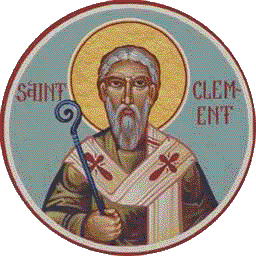 One of the aspects lacking in my (Protestant) seminary training, before my reversion to Catholicism occurred, was a proper exposure to Patristics (the Fathers of the Church). I can only recall one course where the professor would even make mention of any of the early Fathers (it was a history of Christianity course where it really couldn’t be avoided).
One of the aspects lacking in my (Protestant) seminary training, before my reversion to Catholicism occurred, was a proper exposure to Patristics (the Fathers of the Church). I can only recall one course where the professor would even make mention of any of the early Fathers (it was a history of Christianity course where it really couldn’t be avoided).
When one dives (or even wades) into the writings of the early Fathers, it becomes blatantly obvious how Catholic they really were – clearly explaining many doctrines which the Church still teaches today, but which Protestants often reject. The reason why these doctrines are often rejected by Protestants is a claim that “the early Christians never believed these ‘Catholic’ teachings – they are later accretions to the Gospel which were ‘invented’ by the Church of Rome” – a claim which becomes spurious when faced with actual evidence – evidence that the successors of the Apostles themselves believed these things. They were taught these things by the Apostles, who were in turn taught them by Christ.
One such piece of evidence comes from the writings of Clement of Rome, third in the line of succession as the Bishop of Rome from Peter. And this quote from our third Pope is on just that, Apostolic Succession. This is a doctrine that is denied not only in theory but also in practice by the majority of today’s Protestants – mostly because their practice of Protestantism depends on doing just that.
“Our Apostles knew through our Lord Jesus Christ that there would be strife for the office of bishop. For this reason, therefore, having received perfect foreknowledge, they appointed those who have already been mentioned, and afterwards added the further provision that, if they should die, other approved men should succeed to their ministry.”
– St. Clement of Rome, Letter to the Corinthians, 44:1-2, c. AD 80
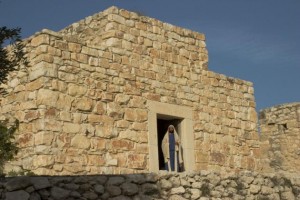
Synagogue at Nazareth
Today’s Gospel reminds us of a key point:
Lk 4:16-30
Jesus came to Nazareth, where he had grown up,
and went according to his custom
into the synagogue on the sabbath day.
He stood up to read and was handed a scroll of the prophet Isaiah.
He unrolled the scroll and found the passage where it was written:
The Spirit of the Lord is upon me,
because he has anointed me
to bring glad tidings to the poor.
He has sent me to proclaim liberty to captives
and recovery of sight to the blind,
to let the oppressed go free,
and to proclaim a year acceptable to the Lord.
Rolling up the scroll,
he handed it back to the attendant and sat down,
and the eyes of all in the synagogue looked intently at him.
He said to them,
“Today this Scripture passage is fulfilled in your hearing.”
And all spoke highly of him
and were amazed at the gracious words that came from his mouth.
They also asked, “Is this not the son of Joseph?”
He said to them, “Surely you will quote me this proverb,
‘Physician, cure yourself,’ and say, ‘Do here in your native place
the things that we heard were done in Capernaum.’”
And he said,
“Amen, I say to you, no prophet is accepted in his own native place.
Indeed, I tell you,
there were many widows in Israel in the days of Elijah
when the sky was closed for three and a half years
and a severe famine spread over the entire land.
It was to none of these that Elijah was sent,
but only to a widow in Zarephath in the land of Sidon.
Again, there were many lepers in Israel
during the time of Elisha the prophet;
yet not one of them was cleansed, but only Naaman the Syrian.”
When the people in the synagogue heard this,
they were all filled with fury.
They rose up, drove him out of the town,
and led him to the brow of the hill
on which their town had been built, to hurl him down headlong.
But he passed through the midst of them and went away.
It was very clear that the townspeople of Nazareth were shocked at the wisdom of Christ. The “unveiling”, literally “revelation” (Gk) of the true identity of Jesus was beginning.
Clearly, Jesus would have been known to the people of his adopted hometown of Nazareth as a hard worker, the son of Mary, and, so it was thought, of Joseph. No doubt he was an upstanding citizen and full of virtue. But Jesus did not seek to stand out in any strange way, to draw attention to himself before the opportune time, before his “hour” to borrow an expression from the fourth gospel, had come; before his public ministry began.
As a friend of mine once said, the hierarchy of the Church are to show forth and replicate the public life of Christ, while the laity are called to replicate the so called “hidden” life of Christ – which was actually the vast majority of his earthly life – sanctifying themselves, their work, and others, for Christ’s sake, in a completely natural way.
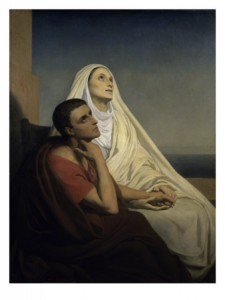 With yesterday being the feast of Saint Monica, and today being that of Saint Augustine, her son, there’s no better occasion to remember that no one, no matter how grievous a sinner or how far one has strayed from the Church, is beyond redemption. Case in point: Augustine. His younger years were spent in the type of dissolution Saint Paul condemns in today’s first reading:
With yesterday being the feast of Saint Monica, and today being that of Saint Augustine, her son, there’s no better occasion to remember that no one, no matter how grievous a sinner or how far one has strayed from the Church, is beyond redemption. Case in point: Augustine. His younger years were spent in the type of dissolution Saint Paul condemns in today’s first reading:
Brothers and sisters,
we earnestly ask and exhort you in the Lord Jesus that,
as you received from us
how you should conduct yourselves to please God–
and as you are conducting yourselves–
you do so even more.
For you know what instructions we gave you through the Lord Jesus.
This is the will of God, your holiness:
that you refrain from immorality,
that each of you know how to acquire a wife for himself
in holiness and honor, not in lustful passion
as do the Gentiles who do not know God;
not to take advantage of or exploit a brother or sister in this matter,
for the Lord is an avenger in all these things,
as we told you before and solemnly affirmed.
For God did not call us to impurity but to holiness.
Therefore, whoever disregards this,
disregards not a human being but God,
who also gives his Holy Spirit to you.
By the time Augustine was in his 20s, he had left the Church, fathered a child out of wedlock, and joined a cult (the Manichees)! His mother, Monica, like so many mothers of wayward children today, despaired of her son’s salvation. But, her pastor, Ambrose (who also became a saint!), gave her some sage advice: “Spend more time talking to God about Augustine than you do talking to Augustine about God”.
Monica’s prayers were answered in time. Not only did Augustine return to the Faith, but her unbelieving husband became a Catholic as well. Augustine had to take classes from Ambrose in order to reenter the Church (the equivalent, of sorts, of an RCIA class today). During this time, he took on another mistress! Augustine famously prayed at this time, “Lord, make me chaste, but not yet!”.
But, eventually, Augustine realized the incredible dangers of sexual sin, as the first reading strikingly reminds us. And he also realized that only God could satisfy his need for love. To this end he wrote a far more famous prayer, perhaps the greatest line ever written outside of Sacred Scripture: “You have made us for yourself, O Lord, and our hearts are restless until they rest in You”.
If Augustine could become a saint, so can I. And, so can you: “This is the will of God, your holiness”.


